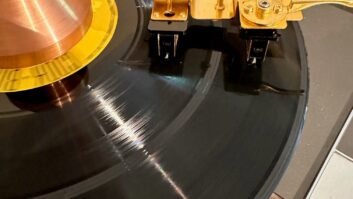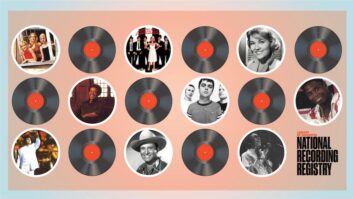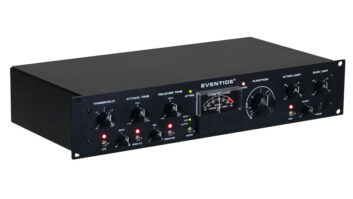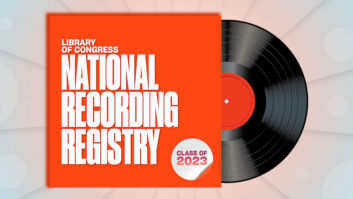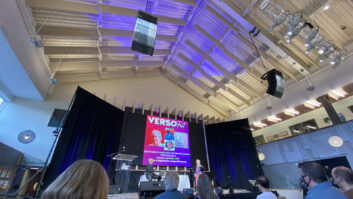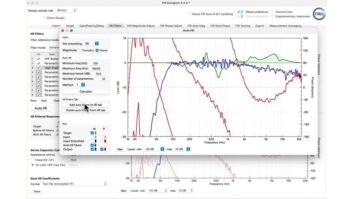Librarian of Congress James H. Billington announced his selection ofthe first 50 historic sound recordings to be added to the NationalRecording Registry in Washington, D.C. Congress has charged theLibrarian of Congress with the responsibility of selecting recordingsannually that are “culturally, historically or aestheticallysignificant.” Nominations were garnered from members of the public andthe National Recording Preservation Board, which is composed of leadersin the fields of music, recorded sound and preservation; the Board alsohelped with the review of nominations.
As a member of the Board, the Audio Engineering Society (AES)advised the Librarian on his selection. Representing the AES on theBoard are Elizabeth Cohen, AES past president, and GeorgeMassenburg.
The selection, in chronological order, is: Edison ExhibitionRecordings (Group of three cylinders): “Around the World on thePhonograph,” “The Pattison Waltz;” “Fifth Regiment March” (1888-1889);The Jesse Walter Fewkes field recordings of the Passamaquoddy Indians(1890); “Stars and Stripes Forever” Military Band, Berliner Gramophonedisc recording (1897); Lionel Mapleson cylinder recordings of theMetropolitan Opera (1900-1903); Scott Joplin ragtime compositions onpiano rolls, Scott Joplin, piano (1900s); Booker T. Washington’s 1895Atlanta Exposition Speech (1906 re-creation); “Vesti la Giubba” fromPagliacci, Enrico Caruso (1907); “Swing Low, Sweet Chariot,” FiskJubilee Singers (1909); Lovey’s Trinidad String Band recordings forColumbia Records (1912); “Tiger Rag,” original Dixieland Jazz Band(1918); “Arkansas Traveler” and “Sallie Gooden,” Eck Robertson, fiddle(1922); “Down-Hearted Blues,” Bessie Smith (1923); “Rhapsody in Blue,”George Gershwin, piano; Paul Whiteman Orchestra (1924); LouisArmstrong’s Hot Five and Hot Seven recordings (1925-1928); VictorTalking Machine Company sessions in Bristol, Tenn., Carter Family,Jimmie Rodgers, Ernest Stoneman and others (1927); Harvard Vocariumrecord series, T. S. Eliot, W. H. Auden and others, reciting(1930-1940s); Highlander Center Field Recording Collection. Rosa Parks,Esau Jenkins and others (1930s-1980s); Bell Laboratories experimentalstereo recordings, Philadelphia Orchestra, Leopold Stokowski, conductor(1931-1932); President Franklin D. Roosevelt’s radio “Fireside Chats”(1933-1944); New Music Recordings series, Henry Cowell, producer(1934-1949); description of the crash of the Hindenburg, HerbertMorrison reporting (1937); “Who’s on First,” Abbott and Costello’sfirst radio-broadcast version (1938); “War of the Worlds,” Orson Wellesand the Mercury Theater (1938); “God Bless America,” Kate Smith, radiobroadcast premiere (1938); “The Cradle Will Rock,” Marc Blitzstein andthe original Broadway cast (1938); The John and Ruby Lomax SouthernStates Recording Trip (1939); Grand Ole Opry, first network radiobroadcast, Uncle Dave Macon, Roy Acuff (1939); “Strange Fruit,” BillieHoliday (1939); Duke Ellington Orchestra “Blanton-Webster Era”recordings (1940-1942); Bela Bartok, piano, and Joseph Szigeti, violin,in concert at the Library of Congress (1940); “Rite of Spring,” IgorStravinsky conducting the New York Philharmonic (1940); “WhiteChristmas,” Bing Crosby (1942); “This Land is Your Land,” Woody Guthrie(1944); General Dwight D. Eisenhower’s D-Day radio address to theAllied Nations (1944); “Koko,” Charlie Parker, Miles Davis, DizzyGillespie and others (1945); “Blue Moon of Kentucky,” Bill Monroe andThe Blue Grass Boys (1947); “How High the Moon,” Les Paul and Mary Ford(1951);. Elvis Presley’s Sun Records sessions (1954-1955); Songs forYoung Lovers, Frank Sinatra (1955); Dance Mania, Tito Puente(1958); Kind of Blue, Miles Davis, John Coltrane, CannonballAdderley, Bill Evans and others (1959); “What’d I Say,” parts 1 and 2,Ray Charles (1959); “I Have a Dream” speech by Dr. Martin Luther KingJr. (1963); “Freewheelin,'” Bob Dylan (1963); “Respect!” ArethaFranklin (1967); Philomel: for soprano, recorded soprano, andsynthesized sound, Bethany Beardslee, soprano (1971); Precious Lord:New Recordings of the Great Gospel Songs of Thomas Dorsey, ThomasDorsey, Marion Williams and others (1973); Crescent City LivingLegends Collection (WWOZ radio, New Orleans) (1973-1990); and “TheMessage,” Grandmaster Flash and The Furious Five (1982).
Complete annotations for each recording and information on theNational Recording Preservation Board can be found out www.loc.gov/rr/record/. For information on the AESTechnical Committee on Archiving Restoration and Digital Libraries,please visit www.aes.org.
